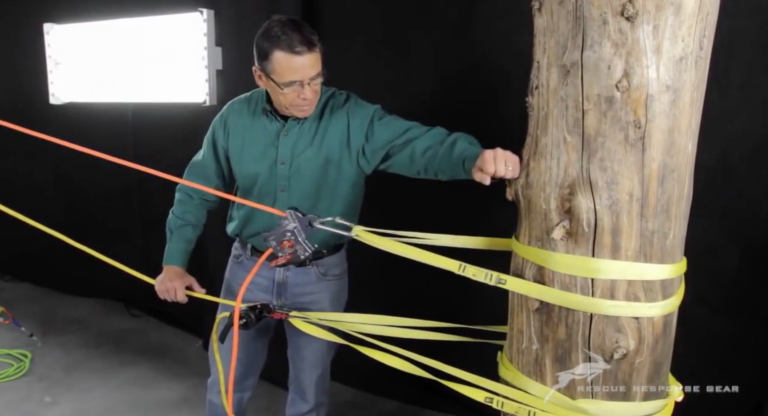Rigging is essential for rescue operations, climbing, and industrial applications. Mastering the key elements ensures safety and efficiency. This comprehensive guide covers crucial aspects, including bombproof anchors, understanding resultants, mastering knots, setting up highlines, confined space rescue techniques, mechanical advantage systems, reeving systems, friction management, and slackline rigging, offering valuable insights for professionals and enthusiasts alike.
Section 1: Bombproof Anchors
Overview: Bombproof anchors are essential for ensuring the safety and stability of a rigging system. These anchors must withstand the highest loads and provide a reliable foundation.
Key Considerations:
- Materials: Use high-strength materials like steel and aluminum.
- Placement: Ensure anchors are placed in solid, stable surfaces.
- Testing: Regularly test anchors to confirm their strength and reliability.
Practical Tips:
- Inspect anchors before each use.
- Use redundant anchors for added safety.
- Avoid using anchors with visible damage or wear.
Example Scenarios:
- Setting up anchors in rock climbing.
- Using anchors in high-angle rescue operations.
For more details, visit Rigging Lab Academy – Bombproof Anchors (Rigging Lab Academy).
Section 2: Understanding Resultants
Overview: Resultants are the force vectors created when two components come together in a rigging system. Understanding these forces is crucial for maintaining balance and stability.
Force Vectors:
- Creation: Resultants are formed by the joining of two components, such as ropes or pulleys.
- Calculation: Use parallelograms to visualize and calculate resultant forces.
Pulley Systems:
- Pulleys equalize forces and help distribute load efficiently.
Case Study:
- A detailed case study showing the practical application of understanding resultants in a highline setup.
For more information, visit Rigging Lab Academy – Understanding Resultants (Rigging Lab Academy).
Section 3: Knots, Bends, and Hitches
Overview: Knot craft is a foundational skill in rigging, enabling the secure joining of ropes and other components.
Essential Knots:
- Figure-Eight Knot: Commonly used for securing ropes.
- Bowline: Ideal for forming loops that don’t slip.
- Clove Hitch: Useful for securing ropes to posts or rails.
Applications:
- Securing loads.
- Creating adjustable loops.
- Joining ropes.
Tips:
- Practice tying knots regularly.
- Test knots under load to ensure they hold.
Learn more at Rigging Lab Academy – Knots and Pulleys (Rigging Lab Academy).
Section 4: Highlines and Force Vectors
Overview: Highlines are used in rescue operations and adventure sports. Proper load distribution and managing critical angles are key to their safety.
Load Distribution:
- Ensure equal load distribution to prevent anchor failure.
- Use pulleys and anchors strategically.
Construction Tips:
- Use high-strength materials.
- Double-check all connections and knots.
Mathematical Insights:
- Apply simple trigonometry to calculate angles and forces.
For more details, visit Rigging Lab Academy – Highlines (search “highlines”).
Section 5: Confined Space Rescue
Overview: Confined space rescues present unique challenges due to limited access and movement.
Tripods and Portable Anchors:
- Essential for providing a stable rigging point in confined spaces.
Techniques:
- Lowering Systems: Safely lower rescuers or equipment.
- Raising Systems: Efficiently lift victims or materials.
Safety Tips:
- Monitor air quality in confined spaces.
- Use personal protective equipment (PPE).
Explore more at Rigging Lab Academy – Confined Space Rescue (Rigging Lab Academy).
Section 6: Mechanical Advantage Systems
Overview: Mechanical advantage systems reduce the effort required to lift heavy loads using pulleys and levers.
Pulley Systems:
- Simple Pulley: Basic system for direct lifting.
- Compound Pulley: Increases mechanical advantage by combining multiple pulleys.
Calculation Examples:
- Determine mechanical advantage using the ratio of pulleys used.
Applications:
- Rescue operations.
- Industrial lifting.
Find out more at Rigging Lab Academy – Mechanical Advantage (search “mechanical advantage”).
Section 7: Reeving Systems
Overview: Reeving systems involve threading ropes through pulleys to distribute load and reduce effort.
Step-by-Step Guide:
- Choose appropriate pulleys.
- Thread ropes through pulleys systematically.
- Secure ends and test the system.
Types:
- English Reeve: Common in rescue scenarios.
- Double Pulley Systems: For higher mechanical advantage.
Use Cases:
- High-angle rescues.
- Heavy lifting in industrial settings.
Learn more at Rigging Lab Academy – Reeving Systems (Rigging Lab Academy).
Section 8: Friction Management
Overview: Friction affects the efficiency of rigging systems and must be managed to maintain safety and performance.
Managing Friction:
- Use lubricants on moving parts.
- Select materials with low friction coefficients.
Anchor Considerations:
- Ensure anchor points can handle frictional forces.
Best Practices:
- Regular maintenance of equipment.
- Monitor friction levels during operations.
For more information, visit Rigging Lab Academy – Friction Management (search “friction management”).
Section 9: Slackline Rigging
Overview: Slacklining involves balancing on a tensioned line and is used in both recreational and professional rigging.
Basic to Advanced:
- Primitive Systems: Simple setups for beginners.
- Ratchet Systems: Provide more tension and stability.
Equipment and Setup:
- Use webbing and appropriate anchors.
- Ensure proper tension and safety measures.
Safety and Ethics:
- Always use backup lines.
- Respect the environment and other users.
Explore more at Rigging Lab Academy – Slackline Rigging (Rigging Lab Academy).
Conclusion
Understanding and mastering the elements of rigging is essential for safety and efficiency in various applications. This guide provides a comprehensive overview, but continued learning and practice are crucial. For more in-depth information and training, explore additional resources and courses at Rigging Lab Academy.
Call to Action
- Subscribe to our blog for more in-depth articles.
- Share your experiences or ask questions in the comments section.
- Contact us for personalized training or consultations.
By including links to Rigging Lab Academy, readers can easily access more detailed information and resources to deepen their understanding of each topic.










